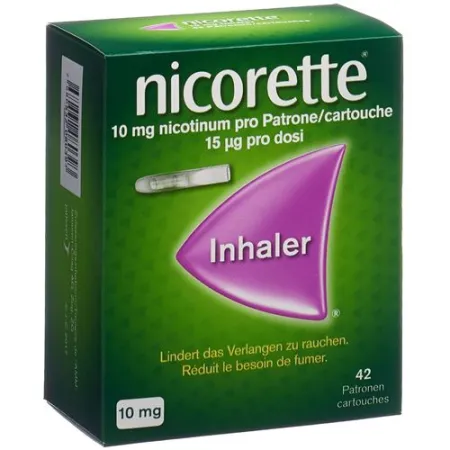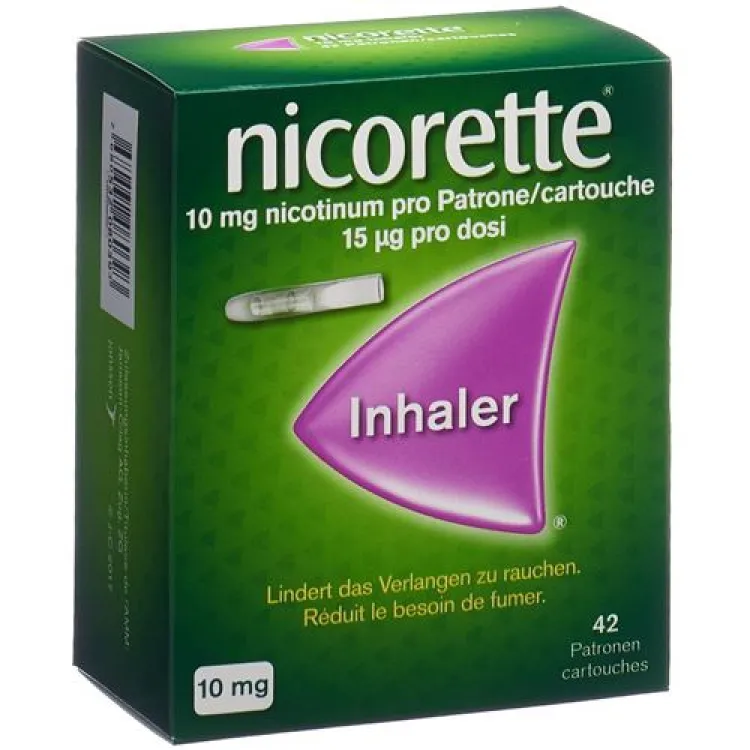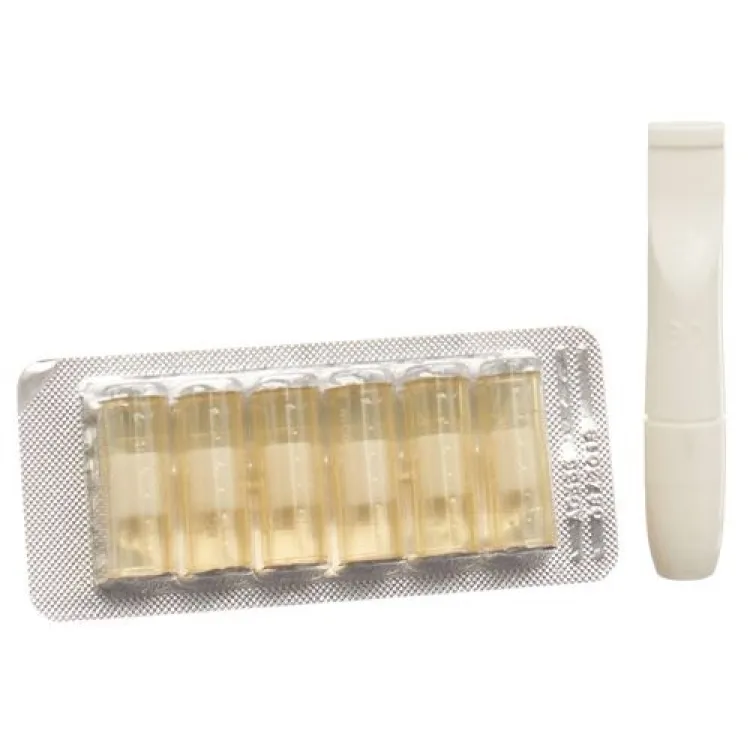Nicorette Inh 10 mg 42 pcs
Nicorette Inh 10 mg 42 Stk
-
171.48 USD

- Availability: Out of stock
- Distributor: JOHNSON & JOHNSON
- Brand: Nicorette
- Product Code: 2153127
- ATC-code N07BA01
- EAN 7680532080393
Ingredients:
Description
Nicorette Inhaler is recommended as an aid to quitting smoking or reducing cigarette consumption as a first step.
Nicorette Inhaler consists of a cartridge with a nicotine-loaded plastic insert, from which nicotine is inhaled with the breathing air using a mouthpiece. Nicotine is the addictive component in tobacco smoke and is responsible for the various withdrawal symptoms associated with smoking cessation. The controlled administration of nicotine with the inhaler reduces these withdrawal symptoms and makes it easier for the smoker to give up cigarette nicotine. This roughly doubles the chances of successfully quitting smoking.
Once you have acquired new habits (substitute actions for smoking) over a period of time, experience has shown that you will find it easier to gradually reduce the amount of nicotine in Nicorette Inhaler and later to give up entirely.
Health damage caused by the tar and carbon monoxide content in tobacco smoke is avoided.
Only long-term abstinence reduces tobacco-related disease and mortality.
Swissmedic-approved patient information
Nicorette® Inhaler
What is Nicorette Inhaler and when is it used?
Nicorette Inhaler is recommended as an aid to quitting smoking or reducing cigarette consumption as a first step.
Nicorette Inhaler consists of a cartridge with a nicotine-loaded plastic insert, from which nicotine is inhaled with the breathing air using a mouthpiece. Nicotine is the addictive component in tobacco smoke and is responsible for the various withdrawal symptoms associated with smoking cessation. The controlled administration of nicotine with the inhaler reduces these withdrawal symptoms and makes it easier for the smoker to give up cigarette nicotine. This roughly doubles the chances of successfully quitting smoking.
Once you have acquired new habits (substitute actions for smoking) over a period of time, experience has shown that you will find it easier to gradually reduce the amount of nicotine in Nicorette Inhaler and later to give up entirely.
Health damage caused by the tar and carbon monoxide content in tobacco smoke is avoided.
Only long-term abstinence reduces tobacco-related disease and mortality.
What should be considered?
Your motivation and willpower are decisive for the success of the treatment.
If you are using Nicorette Inhaler as part of a cessation treatment, you should refrain from smoking altogether, since excessive nicotine intake carries the risk of a nicotine overdose. It is therefore important that you are strongly motivated to quit smoking before starting Nicorette inhaler treatment. Professional smoking advice increases the chances of quitting successfully.
When must Nicorette Inhaler not be used?
Nicorette Inhaler must not be used in patients with known hypersensitivity to nicotine or other ingredients of Nicorette Inhaler. Nicorette Inhaler must not be used by non-smokers, children under the age of 12 and, in principle, by young people under the age of 18 and over the age of 12! For young people, the preparation should only be used if they are heavily dependent on nicotine and only after consultation with their doctor or pharmacist.
When should you be careful when using Nicorette Inhaler?
If you have any medical condition, chronic throat conditions or any of the following conditions, you should you carefully discuss the benefits and risks with your doctor before starting the treatment program with Nicorette:
Diabetes, kidney and liver diseases, hyperthyroidism, pheochromocytoma (adrenaline-producing tumor of the adrenal gland), as well as inflammation of the esophagus or stomach and intestinal ulcers.
Smoking addicts immediately (less than four weeks) after a heart attack, with unstable or worsening angina pectoris, severe cardiac arrhythmia, uncontrolled high blood pressure or recent stroke should only use Nicorette Inhaler under medical supervision. In these cases, the use of the drug should only be considered if smoking cessation is not possible without medical support. If new cardiovascular symptoms develop or existing symptoms worsen (chest pain, irregular pulse, shortness of breath), a doctor should be consulted.
This medicine may impair your ability to react, your ability to drive and your ability to use tools or machines!
Quiting smoking, with or without Nicorette Inhaler, may change response to concomitant medicines for asthma, cardiac arrhythmia, severe pain, mood disorders, Alzheimer's disease, Parkinson's disease or diabetes (insulin). Your doctor may prescribe a dose adjustment of the medicines concerned.
Tell your doctor, pharmacist or druggist if you
- suffer from other diseases,
- have allergies or
- take other medicines (including those you bought yourself!).
Can Nicorette Inhaler be used during pregnancy or breastfeeding?
Smoking cessation is the single most effective measure to improve the health of the pregnant smoker and the baby. The sooner you give up nicotine, the better.
No forms of nicotine should be used during pregnancy. Nicotine, and especially smoking, can seriously endanger the health of the fetus and child and should be discontinued during pregnancy. Pregnant women who smoke should only use Nicorette Inhaler after consulting a doctor, pharmacist or druggist.
No form of nicotine should be taken/used while breastfeeding. If smoking cessation is not achieved, Nicorette Inhaler should only be used in breast-feeding smokers after consulting a doctor, pharmacist or druggist. Should nicotine substitution be necessary during breastfeeding, Nicorette Inhaler should be used immediately after breastfeeding and as much time as possible should be allowed before the next breastfeeding (at least 2 hours).
How do you use Nicorette Inhaler?
Nicorette Inhaler is intended for adults over 18 years of age. For young people under the age of 18 and over the age of 12, the preparation should only be used if they are heavily dependent on nicotine and only after consultation with the doctor.
Weaning
In order to achieve effective control of withdrawal symptoms, a minimum of 6 and a maximum of 12 inhaler cartridges per day should be used for up to eight weeks. Within this framework, the dosage is individual and depends on your need for nicotine to reduce withdrawal symptoms. One cartridge corresponds to 4 cigarettes and allows about four uses of about 20 minutes each. With a cigarette consumption of 24 cigarettes per day, 6 cartridges should be used. With continuous and forced inhalation over 20 minutes, a maximum of 4 mg is released from one inhaler under laboratory conditions. However, the frequency and type of inhalation vary from person to person and depend on the intensity of the withdrawal symptoms. For example, an inhaler cartridge can be used on four occasions for five minutes. Experience has shown that after using a few inhaler cartridges you will find the application method that is best for you.
After eight weeks, it's time to start gradually cutting back on nicotine. You should halve the number of cartridges you use over the next two weeks, so that after another two weeks the number will drop to zero on the last day of treatment. The total duration of treatment is limited to three months.
Reduction of cigarette consumption
The inhaler is used during the smoke-free intervals in order to prolong them as long as possible and thus reduce cigarette consumption as much as possible. If you have not achieved a significant reduction in your daily cigarette consumption after 6 weeks, you should seek advice from your doctor.
You should try to quit smoking as soon as you feel ready, but no later than six months after starting treatment. If you are still unable to stop smoking nine months after starting treatment, you should see your doctor.
The recommended duration of treatment with Nicorette Inhaler is a maximum of 12 months.
Stick to the dosage given in the package leaflet or as prescribed by your doctor. If you think the medicine is too weak or too strong, talk to your doctor, pharmacist or druggist.
Instructions for use
- Remove the mouthpiece and sealed blister container from the box. Remove the plastic cover from the mouthpiece. Disassemble the two-piece mouthpiece by lining up the marks. Carefully peel back the aluminum foil from the blister container so that you can remove a cartridge.
- Remove the sealed inhaler cartridge from the container and press it firmly into the bottom of the mouthpiece, breaking the seal . Align the marks again and press both mouthpiece parts firmly together until the top cartridge seal is also open.
- Now twist the marks apart so that they are no longer in line. This closes the mouthpiece (child safety). Put the container with the remaining inhaler cartridges back into the box. Nicorette Inhaler is now ready to use. If the inhaler is stored with the seal once broken, the nicotine concentration will decrease. An opened inhaler cartridge should therefore be used within 12 hours.
- After using the inhaler cartridge, remove it from the mouthpiece and dispose of the used cartridge out of the reach of children and pets.
Note
Nicotine release from the inhaler may be reduced at low ambient temperatures. At lower temperatures, the inhaler should be used for a longer time to achieve the same effect.
What side effects can Nicorette Inhaler have?
Nicorette Inhaler can cause the same side effects as other forms of nicotine. These are generally dose dependent.
Some of the undesirable effects of quitting smoking can be withdrawal symptoms due to reduced nicotine intake. These include irritability, aggression, impatience, frustration, anxiety, restlessness, difficulty concentrating, waking up late at night, trouble sleeping, increased appetite, weight gain, constipation, feeling depressed, craving to smoke, slow heart rate, bleeding gums, dizziness, lightheaded, cough, sore throat, mouth ulcers, stuffy or runny nose. If you stop smoking, canker sores can also develop. The reason for this is not known.
Very common (affects more than 1 user in 10)
Headache, hiccups, cough, throat irritation, nausea.
Common (affects 1 to 10 users in 100)
Hypersensitivity reactions, taste disturbances, sensory disturbances, burning sensation in the mouth and throat, nasal congestion, sinusitis, vomiting, indigestion, intestinal gas, Stomach pain, diarrhoea, heartburn, dry mouth, increased salivation, inflammation of the lining of the mouth, burning sensation in the mouth/lips, tiredness.
Uncommon (affects 1 to 10 users in 1000)
Abnormal dreams, flushing, palpitations, fast heartbeat, worsening of symptoms of heart disease such as angina pectoris, changes in blood pressure, increased Blood pressure, difficulty breathing, sneezing, pain in the mouth, tightness in the throat, increased sweating, itching, rash, hives, flaking of the lining of the mouth. Changes in voice, belching, inflammation of the tongue, abnormal sensations in the mouth, frequent urination, chest pain and discomfort, weakness, feeling unwell.
Rare (affects 1 to 10 users in 10,000)
Difficulty swallowing, nausea, decreased sensitivity in the mouth.
Clear vision, allergic reactions, dry throat, gastrointestinal problems, swelling of the face/neck, increased tear production, lip pain and reddening of the skin have also been reported.
Persistent nicotine addiction can occur. If you notice side effects, contact your doctor, pharmacist or druggist. This also applies in particular to side effects that are not listed in this leaflet.
Overdose
Overdose can occur if you use other forms of nicotine at the same time as Nicorette inhaler treatment (e.g. if you continue to smoke excessive cigarettes) . In the event of an overdose, the signs correspond to those of acute nicotine poisoning. The following occur: nausea, salivation, abdominal pain, vomiting, low temperature, diarrhea, sweating, headache, dizziness, hearing disorders and pronounced weakness. In extreme cases, the following can follow: drop in blood pressure, weak, irregular pulse, shortness of breath and fainting.
In this case, the nicotine supply must be stopped immediately.
If you suspect nicotine poisoning in a child, or if a child has taken Nicorette Inhaler, or if you have used more Nicorette Inhaler than recommended, contact your doctor or go to the nearest hospital straight away. Doses that are well tolerated by adult smokers can cause severe and possibly life-threatening symptoms of intoxication in children.
What else needs to be considered?
The medicinal product may only be used up to the date marked «EXP» on the container.
Use after opening
An opened inhaler cartridge should be used within 12 hours.
Storage Instructions
Store at room temperature (15-25 °C).
Keep out of the reach of children.
Further information
Nicotine is a highly toxic substance, especially for children. Even at a dosage that is well tolerated by adult smokers during treatment with Nicorette Inhaler, nicotine can lead to severe symptoms of poisoning in children, i. the use of Nicorette Inhaler, if not recognized in time, can be life-threatening for children. Even after use, the cartridge may still contain nicotine. Therefore, both used and unused cartridges must be kept out of the reach of children at all times and disposed of.
Your doctor, pharmacist or druggist can provide you with further information. These people have the detailed information for specialists.
What does Nicorette Inhaler contain?
Nicorette Inhaler consists of a cartridge with a nicotine-loaded plastic insert from which nicotine is inhaled with the breathing air using a mouthpiece.
Active ingredients
1 inhaler cartridge contains 10 mg nicotine. Up to 4 mg nicotine is released per cartridge (see also «How do you use Nicorette Inhaler?»).
Excipients
Levomenthol as a flavoring.
Approval number
53208 (Swissmedic).
Where can you get Nicorette Inhaler? What packs are available?
In pharmacies and drugstores, without a doctor's prescription.
Packs of 42 inhaler cartridges and a mouthpiece.
Authorization holder
Janssen-Cilag AG, Zug, ZG.
This leaflet was last checked by the medicines authority (Swissmedic) in October 2019.





